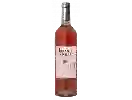
Winery La Font des GarriguesCostières-de-Nîmes Rosé
This wine generally goes well with beef, lamb or mature and hard cheese.
Food and wine pairings with Costières-de-Nîmes Rosé
Pairings that work perfectly with Costières-de-Nîmes Rosé
Original food and wine pairings with Costières-de-Nîmes Rosé
The Costières-de-Nîmes Rosé of Winery La Font des Garrigues matches generally quite well with dishes of beef, lamb or spicy food such as recipes of beef goulash, saddle of lamb stuffed with chicken breast and basil or caramel pork.
Details and technical informations about Winery La Font des Garrigues's Costières-de-Nîmes Rosé.
Discover the grape variety: Mourvèdre
Mourvèdre noir is a grape variety originating from Spain. It produces a variety of grape specially used for wine making. It is rare to find this grape to eat on our tables. This variety of grape is characterized by medium to large bunches, and grapes of medium size. Mourvèdre noir can be found in several vineyards: South-West, Cognac, Bordeaux, Provence & Corsica, Rhône valley, Languedoc & Roussillon, Loire valley, Savoie & Bugey, Beaujolais.
Informations about the Winery La Font des Garrigues
The Winery La Font des Garrigues is one of of the world's greatest estates. It offers 10 wines for sale in the of Costières-de-Nîmes to come and discover on site or to buy online.
The wine region of Costières-de-Nîmes
The wine region of Costières-de-Nîmes is located in the region of Rhône méridional of Rhone Valley of France. Wineries and vineyards like the Domaine Scamandre or the Château d'Or et de Gueules produce mainly wines red, pink and white. The most planted grape varieties in the region of Costières-de-Nîmes are Mourvèdre, Roussanne and Viognier, they are then used in wines in blends or as a single variety. On the nose of Costières-de-Nîmes often reveals types of flavors of non oak, thyme or raisin and sometimes also flavors of clove, cocoa or coffee.
The wine region of Rhone Valley
The Rhone Valley is a key wine-producing region in Southeastern France. It follows the North-south course of the Rhône for nearly 240 km, from Lyon to the Rhône delta (Bouches-du-Rhône), near the Mediterranean coast. The Length of the valley means that Rhône wines are the product of a wide variety of soil types and mesoclimates. The viticultural areas of the region cover such a distance that there is a widely accepted division between its northern and southern parts.
News related to this wine
At the heart of the terroirs of Mâcon-Saint-Gengoux-Le-National
Sequence from the video « At the heart of the Mâcon terroir » which offer a stroll at the heart of the Mâcon terroir. It offers a focus on Mâcon-Saint-Gengoux-Le-National, one of the 27 geographical denominations of the Mâcon appellation. Travel through the terroirs of the Mâcon appellation by watching the full video : https://www.youtube.com/watch?v=GF20y1aBZh8 Both are available in French and English. Our social media: Facebook: https://www.facebook.com/BourgogneWines Twitter: https://twitte ...
Chablis takes pride in its subsoil by Ivy NG
On December 10, 2020, four Hong Kong personalities discussed Chablis wines on a live webinar: Yang LU, Master Sommelier and Official Bourgogne Wines Ambassador, Debra MEIBURG, Master of Wine, Ivy NG, Official Bourgogne Wines Ambassador and Rebecca LEUNG, wine expert. In this two-and-a-half-minute clip, Yvy NG describes the unique subsoil that Chablis is so proud of. ...
At the heart of the terroirs of Mâcon-Bray
Sequence from the video « At the heart of the Mâcon terroir » which offer a stroll at the heart of the Mâcon terroir. It offers a focus on Mâcon-Bray, one of the 27 geographical denominations of the Mâcon appellation. Travel through the terroirs of the Mâcon appellation by watching the full video : https://www.youtube.com/watch?v=GF20y1aBZh8 Both are available in French and English. Our social media: Facebook: https://www.facebook.com/BourgogneWines Twitter: https://twitter.com/BourgogneWines/ ...
The word of the wine: Malolactic fermentation
Called second fermentation or malo for short. It is the degradation (under the effect of bacteria) of the malic acid naturally present in the wine into milder, less aggressive lactic acid. Some producers or wineries refuse this operation by "blocking the malo" (by cold and adding SO2) to keep a maximum of acidity which carries the aromas and accentuates the sensation of freshness.














